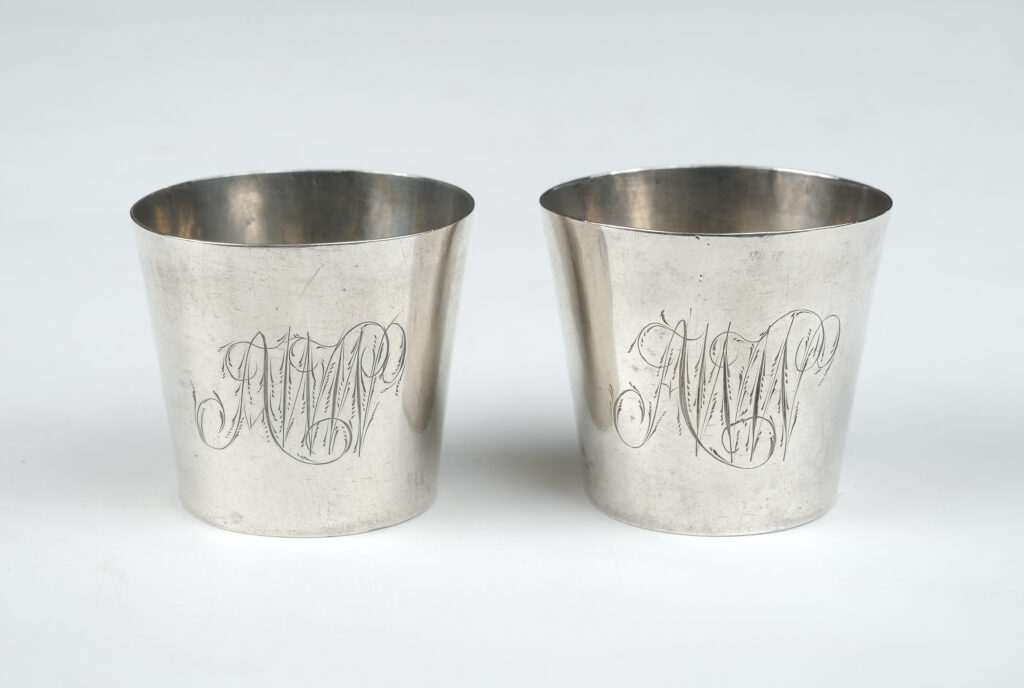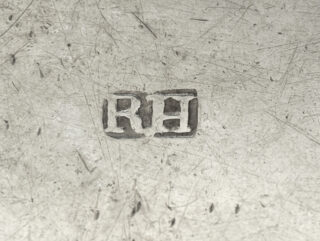
This pair of silver Revolutionary War camp cups was owned by Anthony Walton White, an officer of the Continental Army.
Elegant and finely made yet simple and practical, silver camp cups were commonly part of an eighteenth-century officer’s equipment in the field. The Institute was fortunate to acquire a pair of Revolutionary War camp cups in December 2022. The cups were owned and used during the Revolution by Anthony Walton White (1750-1803), a New Jersey-born officer in the Continental Army and original member of the Society of the Cincinnati. Philadelphia silversmith Richard Humphreys made the cups about 1776. Their purchase for the Institute’s collections was supported by gifts from the New York, South Carolina, and New Jersey branches of the Society of the Cincinnati, the three state societies to which White belonged at various points in his life.
Camp cups were designed for an officer’s life in the field. In contrast with an enlisted man’s cup made of wood or horn, an officer’s silver camp cup indicated his status simply by the material from which it was made. Just over an inch and a half tall, they were easily stackable and portable and were made in sets of between two and twelve cups. Each cup was meant to hold about two ounces of strong spirits or wine and to be replenished often in social settings. These gatherings of officers often occurred in one of their campaign tents or a building they were using as a headquarters. While strategizing, reviewing the day’s events, or sharing news of family and home, they drank from camp cups—not to hydrate and sustain their bodies, but to provide a respite from war and ease their minds in the company of their brothers in arms.
One of these men was Anthony Walton White. Born in New Brunswick, New Jersey, Anthony Walton White joined the Revolution in August 1775 as a volunteer aide-de-camp to Gen. George Washington. After spending a few months with the army in Cambridge, Massachusetts, and not receiving a permanent position on Washington’s staff, White returned home. In early 1776 he was commissioned lieutenant colonel of the Third New Jersey Battalion and served on the frontiers of New York and Canada, including in the defense of Fort Ticonderoga.
In 1777, White was appointed a lieutenant colonel of the Continental Light Dragoons and later ordered by Washington to take command of all the cavalry serving with the southern army. After a series of actions around Charleston in 1780, White was surprised by a British force under Col. Banastre Tarleton, and he and most of his men were taken prisoners. White was exchanged in 1781 and joined Lafayette’s army in Virginia as commander of his cavalry on the campaign to Yorktown. White and his cavalry then accompanied Brig. Gen. Anthony Wayne to Georgia in 1782, where they besieged the city of Savannah until it was evacuated, and then rejoined the main southern army under Nathanael Greene until the war was over.

The silversmith who made the camp cups, Richard Humphreys of Philadelphia, stamped his maker’s mark (his initials) on the underside of each cup.
While in the South, White married Margaret Ellis of Charleston, later moving with her to New York and then to his native New Brunswick, New Jersey. White was an original member of the Society of the Cincinnati, first joining the South Carolina Society and serving as delegate from that society to the first general meeting of the Society of the Cincinnati in Philadelphia in 1784. He subsequently transferred his membership to the New York Society by the late 1780s, and to the New Jersey Society in the 1790s. White was commissioned a general in the New Jersey militia in the 1790s and served as commander of the volunteer cavalry of the Federal Militia Army sent westward in the expedition against the insurgents during the Whiskey Rebellion. During this period he wrote a manual on cavalry service based on his wartime experience that was published in 1793. Later that decade, during the Quasi-War with France, he was appointed a brigadier general in the U.S. Army and served in that capacity until the army was demobilized. He died just a few years later, in February 1803, and is buried at Christ Church in his city where he was born.
Anthony Walton White probably bought his camp cups—originally a set of twelve—in 1776 while serving with George Washington. Washington owned a very similar set of camp cups made by the same silversmith, Richard Humphreys, who stamped his hallmark on the underside of the cups. White had his initials, “AWW,” engraved elegantly on the side of each cup.
View More Silver in the Collections